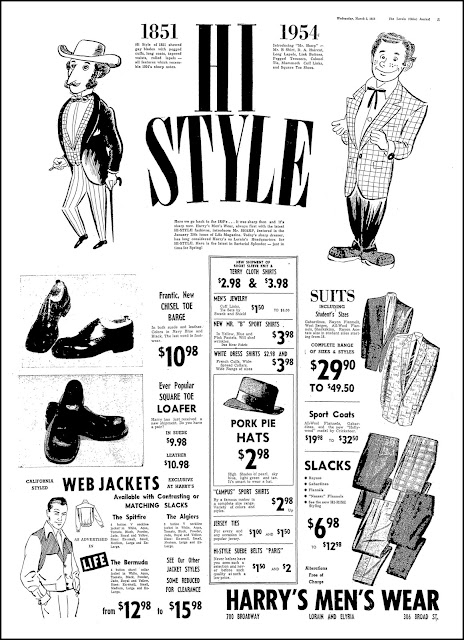Here's a great ad for that Harry's Men's Wear, that venerable Lorain institution that every man visited at some time or another. It ran in the Lorain Journal back on March 3, 1954.
(I've featured Harry's on several occasions, including this 1950 Grand Opening ad, and this 1972 profile of the man.)
The theme of the ad is "Hi Style," which points out the similarities between the men's fashion of 1851 and that of 1954. That's freckle-faced Mr. Sharp on the right, who looks like he might be Archie Andrews' cousin.
As usual in these types of ads, it's fun to see what was in style back then. Suits were available in Gabardines, Rayon Flannels, Wool Serges, All-Wool Flannels, Sharkskins, and Rayon Acetate. (I had a lime green gabardine suit made for me at Ricci Taylors during my senior year of high school!)
I'd never heard of a "web jacket" before. It doesn't seem to be a phrase in common usage. The only reference I found in the Journal's 1954 archives was a reference to a 'web jacket' worn by someone in the Lorain Easter parade. Where did they get it? You guessed it – Harry's.
The part of the ad that did catch my eye was the Pork (suddenly I'm kinda hungry) Pie Hats for $2.98. I had always heard of a pork pie hat as being the type that Buster Keaton wore in his silent comedies.
But this Wiki entry for Pork Pie Hat explains it all pretty well. In addition to Buster (the comic, not our resident blog contributor), architect Frank Lloyd Wright wore one as well. This article compares pork pie hats and fedoras.


Yogi Bear wore one too, so as to be stylish while raiding pic-a-nic baskets.
ReplyDeleteBreaking Bad with Walter White is another good example of a pork pie hat as mentioned in the Wiki link.
ReplyDeleteThat guy wearing the "web jacket."
ReplyDeleteLooks like he's up to no good.
At the very least, don't let him date anybody you know!
funny how copy meaning has changed since 1851.
ReplyDelete